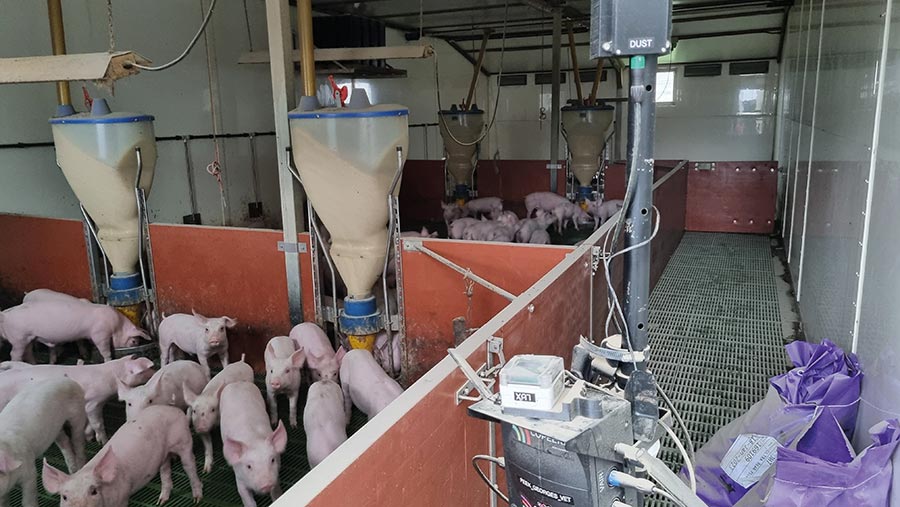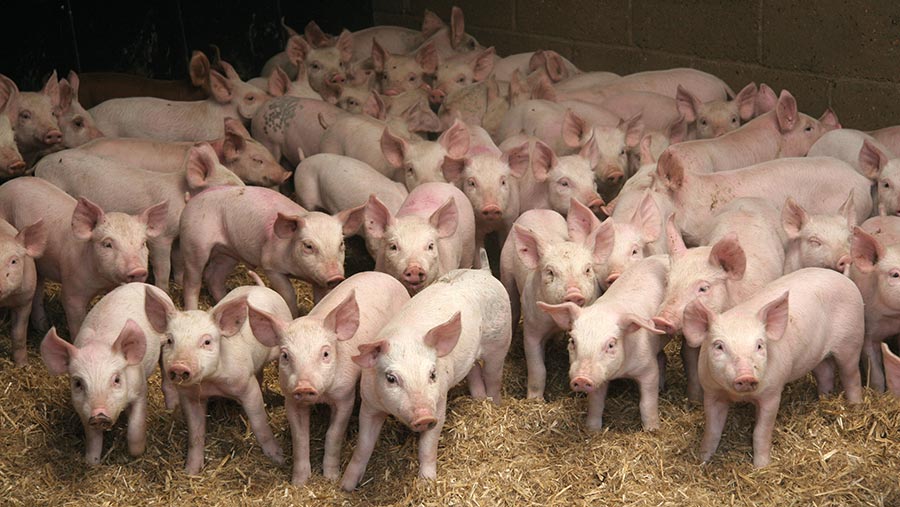Why environmental monitoring can improve pig health and welfare
 Equipment monitoring conditions for pigs © George Vet Group
Equipment monitoring conditions for pigs © George Vet Group Monitoring key environmental parameters in pig buildings can help producers understand their potential influence on pig health and behaviour, investigate the reasons behind problems and take steps to avoid them in future.
This is according to vets Richard Pearson and Tom Hill at George Veterinary Group who are using environmental monitoring equipment on pig units to give additional insight into why the diagnoses they make might be happening.
See also: 11 ways pig farmers can aim for net zero
The equipment continually monitors and records temperature, humidity, carbon dioxide, ammonia, dust and air speed, in real time.
“As vets, we look into how pigs and pathogens interact to produce an outcome, and a large driver in that is the environment,” says Mr Pearson.
“This has often been less acknowledged in the past, or the information has not been available.
“We now need to harness the latest technology for the benefit of pig health, welfare and productivity and, ultimately, to help secure domestic food production.
“We hope that more farmers can benefit from this approach using Defra’s recently launched Animal Health and Welfare Pathway.”
Interpretation of collected data is key and it is important to look at the whole environmental picture, including how parameters interact with each other.
“The aim is to find the best balance of environmental parameters for each individual building and the pigs it houses,” says Mr Hill.
“We also need to take into account the herd’s health status and pig flow when interpreting the information, bringing together all available data sources such as eMB [electronic medicine book for pigs] antibiotics use and Pig Health Scheme abattoir reports.
“We’re only just beginning to understand what the environmental data can tell us, and the potential is really exciting.”
Here, Mr Pearson and Mr Hill explain what the monitoring kit records and how the information can be used to improve pig health and welfare.
Temperature
Temperature is an important factor that can affect pigs in several ways. For example, hypothermia can be a contributor to post-weaning diarrhoea, while hyperthermia can reduce feed intakes.
Temperature can also have an impact on behaviour, including how pigs lie.
Real-time monitoring has shown that the actual temperature is not always that at which it has been set. Farmers need to make sure their infrastructure is functioning as well as possible.
It is also important to check that the steps taken to maintain correct temperature do not have negative consequences for other parameters, such as reduced air flow, which can lead to higher levels of carbon dioxide and ammonia.
Carbon dioxide
Carbon dioxide measurements are used as an indicator of how temperature is being maintained and how much stale air pigs are breathing.
For example, it could be that vents are being kept closed for longer or they may be kept open while additional heating is used, which affects carbon dioxide levels.
Alternatively, temperature may not be well maintained, but pigs are breathing plenty of fresh air. The right balance will depend on the individual building.
Dust
Dust can be an under-appreciated problem, potentially causing physical insult to the respiratory tract, leading to sneezing and coughing.
Dust particles can carry infectious micro-organisms and ammonia, so there are often multiple consequences.
The monitoring equipment records density and volume of particles, with measurements split into four different particle sizes.
Their size influences how far particles can penetrate the respiratory tract. A muco-ciliary “carpet” protects the lower airways, but the smallest particles can still penetrate deep into the lung.
Ammonia
Ammonia can partially paralyse the ciliated cells in the respiratory tract lining, making them less effective at defending against dust, irritant gases and infectious micro-organisms.
This is because the waving motion of the cilia moves mucous up and out of the respiratory tract.
When there is dust in the environment as well as ammonia, it multiplies the risk of respiratory health problems.
Air speed
Fresh air flow is important, but pigs do not like being caught in a draught, so monitoring air speed and its effects on the pigs is useful.
If it is too high, it can cause chilling, which can unsettle the pigs and affect behaviour.
However, if air speed is too low, it could affect health, for example, contributing to Glassers disease or streptococcal infections.
Air speed is measured as close to pig level as possible, and the data are analysed alongside temperature.
The monitoring equipment includes an anemometer, which measures air speed to an accuracy within 0.1m/sec.
Air speed can be managed in various ways, including fan speed, inlet settings and differences between air pressure inside and outside.
Another measured parameter is humidity, which has important health implications, especially environmental survival and transmission of pig pathogens.
Advice for using environmental monitoring kit

© Tim Scrivener
There is flexibility over when the monitoring equipment is used and for how long.
It is applicable in all types of pig accommodation and has also been used by veterinary colleagues on dairy farms, explain vets Richard Pearson and Tom Hill at George Veterinary Group.
It is typically installed for a seven-day period, at a time when a problem is suspected, and targets a particular stage of production or area of the unit.
This approach works well in an all-in, all-out batch production system and, if useful, the kit can be returned for another seven-day period later in the batch.
Alternatively, in farms operating a weekly production system, the equipment can be placed in particular age groups for a few days before moving on to record pigs a few weeks older.
Over a relatively short time, the “environmental journey” of each pig through the unit can be tracked.
The equipment is usually positioned in a passageway, as close to the pigs as possible, but not in the pen, to avoid damage.
Data monitoring is continuous and is automatically uploaded to cloud storage, typically every 10 or 15 minutes.
If it does not upload, it saves all the data, and this can be manually downloaded later.
Maximum and minimum values are recorded too, providing a full picture of environmental parameters, rather than just an average.
Seasonal adjustments
Ideally, the equipment should be put back on a farm at different times of year to monitor the impact of changes to the seasonal ambient environment and open up an ongoing discussion.
Rather than setting building parameters at a particular level year-round, vets and producers should look to tailor adjustments for the season.
With energy prices so high, and the need to keep reducing farming’s carbon emissions, optimising use of energy is another factor to consider, alongside health and welfare.
Collaboration between advisers
Mr Pearson and Mr Hill often make farm visits with representatives from the farm’s breeding or feed company.
In future, they also see value in co-operating more closely with building firms, which can add the specialist knowledge needed.
Recent experience of joint visits with building consultants has been very positive – sometimes even minor adjustments to control settings, fan cleaning or replacement of worn control cords can make a big difference.

